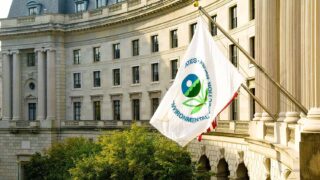- Resources
- Bad for business: The Trump Administration’s attack on EPA’s Endangerment Finding
Resources
Bad for business: The Trump Administration’s attack on EPA’s Endangerment Finding
Published: May 6, 2025 by Sean Hackett
The U.S. Environmental Protection Agency’s Endangerment Finding is under threat. If it is reversed, businesses will face regulatory chaos, uncertainty, and increased risks from investors and the courts.
In 2009, EPA determined that climate pollution endangers public health and welfare. This landmark determination is rooted in extensive scientific evidence and firmly grounded in the law. It confirmed the EPA’s authority and responsibility to reduce this pollution under the Clean Air Act — and has been repeatedly upheld by courts and reaffirmed by the EPA in the years since.
EPA Administrator Lee Zeldin announced plans to reconsider and reverse that finding in March and recently indicated that there would be a forthcoming agency proposal and public comment period.
In an earlier blog, we described the mountain of scientific evidence supporting the Endangerment Finding and how it helps enable EPA to do its job of adopting safeguards that reduce this pollution from large sources, like power plants and motor vehicles. We also described the enormous stakes for communities across the country already experiencing devastating fires, floods, and other extreme weather events if Administrator Zeldin reverses this finding.
There is a lot at stake for companies too: the Endangerment Finding has given rise to a rational, predictable framework for reducing climate pollution that has helped to unlock investment, drive innovation, and advance clean and affordable solutions.
The Endangerment Finding’s stable regulatory framework has unleashed economic growth and innovative investments
Since its adoption in 2009, the Endangerment Finding has helped strengthen the U.S. economy, supporting growth, creating new jobs, and accelerating the adoption of affordable clean energy technologies.
- Economic and job growth: Since 2009, the U.S. automotive and oil and gas sector have seen enormous economic growth while the overall economy has grown annually by about 2.5% on average.
- Automotive Market Growth: In the automotive sector, where standards to reduce greenhouse gas pollution were first adopted in 2010, vehicle production has increased and, over the last 10 years, automakers have nearly $200 billion in U.S. production to build clean vehicles, supporting almost 195,000 jobs.
- Oil and Gas Market Expansion: In the oil and gas sector, greenhouse gas standards for methane have been in place since 2016. Since then, U.S. gas production has increased by more than 40% and oil production has risen by almost 50%. Industry revenue and capital investment has also grown — demonstrating that strong methane standards are fully compatible with industry growth, investment and profitability.
- Increased Innovation: This stable regulatory environment has also unlocked innovation. There has also been enormous innovation in clean vehicles — from a single EV model available in 2009 to more than 70 models this year. And EV range and capabilities have likewise improved dramatically (the median range for an EV has gone from 82 miles in 2012 to 283 in 2024). Methane detection technologies, which were in their infancy prior to 2016, have grown into a more sizeable U.S. industry, supporting jobs and helping oil and gas operators more quickly find and fix methane leaks.
- Declining Costs of Clean Solutions: The costs of clean energy solutions have fallen dramatically in recent years. For example, the cost of electric vehicle (EV) batteries declined by 90% between 2008 and 2023, helping make EVs more affordable. Recent EDF analysis also finds that consumers who choose an EV can save thousands of dollars in avoided fuel and maintenance costs. Similarly, the cost of renewable energy has plummeted: it is now cheaper to build new solar and wind projects and connect them to the grid than it is to continue operating existing coal plants. In fact, solar and wind power produced more electricity than coal for the majority of 2024 in the United States — underscoring how rapidly clean energy is outcompeting fossil fuels on both price and performance.
Industry examples such as these demonstrate that by establishing a consistent and rational system for reducing greenhouse gas emissions, the Endangerment Finding has given businesses the confidence to invest in clean solutions and pursue innovation. It has provided clear and consistent signals to the market, shaping investment strategies and driving the development of new products and services. By setting expectations for supply chain operations, it has allowed for greater efficiency in capital deployment and enabled more agile in sourcing and production practices.
Endangerment Finding propels U.S. competitiveness in global markets
Global markets are rapidly shifting toward lower-carbon energy sources, lower polluting transportation sources and higher environmental standards. The European Union, which received two-thirds of all U.S. LNG exports in 2023, now requires importers to meet stringent emissions standards. Japan and South Korea, representing 25% of global LNG demand, are pursuing similar expectations through the CLEAN Initiative. Similarly, global demand for, and investment in, electric vehicles has grown substantially in recent years.
Without a credible domestic framework, U.S. producers and manufacturers risk losing access to these markets. Maintaining the Endangerment Finding and standards to reduce greenhouse gas emissions ensures that U.S. companies remain competitive in this global competitive marketplace.
Leading companies have invested more than $360 billion in the U.S. alone since the Inflation Reduction Act to cut emissions, reduce methane, produce clean vehicles, and deploy clean energy — not just to meet regulations, but to stay competitive in a global economy that rewards climate leadership. The Endangerment Finding underpins the regulatory certainty that supports these investments and ensures a level playing field for innovators.
Lowering the regulatory floor distorts competition and undermines progress. Strong, consistent federal standards protect investments, drive innovation and help U.S. businesses lead in a market increasingly defined by long-term value and climate performance.
If reversed, companies will face new levels of chaos, risk and economic uncertainty
Companies have seen the severe consequences that regulatory uncertainty driven by rapidly shifting policies can have on their bottom lines. It makes planning and investing nearly impossible and can result in economic and job losses.
If Administrator Zeldin removes the Endangerment Finding, it will create more chaos, risk and uncertainty for businesses already facing too much instability. The threats associated with climate change will remain (as will the need to address it), but the pathways to do so will be less clear. For instance:
- Immediate instability: Businesses would be left in the dark about future emissions limits and reporting requirements, making it harder to plan long-term investments and manage financial risk. Companies that have already significantly invested in emissions reductions and clean energy products and supply chains could be undercut by competitors that have done less.
- State and local policy changes: The Trump administration’s attack on EPA’s fundamental responsibility to address harmful climate pollution opens the field for more forceful state leadership. Where state and local governments may have previously relied on EPA’s national climate pollution standards, they may now choose to develop and pursue their own programs, which may look different in different areas.
- Private litigation: Companies could face additional nuisance and other tort lawsuits for environmental damages and health impacts. Jeff Holmstead, an industry attorney and a former EPA senior official in the George W. Bush administration, said as much in an interview about the Endangerment Finding. Holmstead told Axios that, “There is great concern that reversing the finding would open the door to a lot more nuisance lawsuits against all kinds of industrial companies — and it would eliminate one of the best arguments that oil companies have used to get lawsuits against them dismissed … There is also concern that an effort to overturn the endangerment finding will not hold up in court.”
- Investor pressure: Shareholders are already holding companies accountable for environmental performance. Weakening regulatory climate protections could increase the use of shareholder resolutions and governance challenges.
Industry groups like the Edison Electric Institute and American Petroleum Institute have acknowledged that the federal government has a key role to play on regulation of greenhouse gases, providing critical legal certainty and operational consistency.
Protect your investments: Actions available to defend Endangerment Finding
Companies and investors should start by assessing what’s at stake. Consider how weakening the Endangerment Finding could affect your ability to invest in and innovate products and services, improve supply chain efficiency, and respond with agility to shifting market requirements and opportunities. Ask your trade associations and industry groups to conduct this assessment as well — and to reflect those findings in their advocacy.
Then, use every tool available to prevent this rollback. To preserve the regulatory stability that underpins market confidence and economic growth, companies and investors should:
- Publicly reject efforts to undermine the 2009 Endangerment Finding and highlight the business case for stable, consistent regulations. Options include:
- Signing on to this letter to EPA: https://actnow.edf.org/a/cte-epa-dereg
- Submitting official comments to EPA on any proposed reversal or revision of the Endangerment Finding via Regulations.gov after EPA publishes the proposal in the Federal Register.
- Making public statements in any form, such as press releases, op-eds, blogs, social media posts, or media interviews.
- Engage with peers, trade associations and policymakers and urge them to oppose efforts to undermine the Endangerment Finding and weaken EPA’s authority to regulate greenhouse gases.
Defending the Endangerment Finding protects people and communities from climate-fueled disasters — and gives businesses the regulatory stability they need to invest for the long term, innovate, manage risk, and compete in global markets.

